Identification of Microplastics in Environmental Monitoring Using Pyrolysis–GC–MS Analysis
Microplastics are now recognized as pervasive in the environment, as well as in stormwater, wastewater, ocean water, coastal sediments, drinking water, and even animal tissue. The mismanagement of plastic waste throughout the world is a matter of urgent concern that has led to product bans for small plastics, such as microbeads used in cosmetic products, to larger plastic item, such as bags and straws, that can degrade into microplastics, This concern has also resulted in new and planned requirements to monitor microplastics in the environment. The implementation of monitoring programs requires reliable standardized methods and best practice guidelines, yet environmental measurement and monitoring practitioners still do not have established practices and methods for collecting and analyzing plastic pollution. This deficiency has resulted in significant challenges in the interpretation of research findings for use in corporate or government policy. A major issue with measurement based upon sampling and analysis of microplastics is their unique behavior; environmental microplastics occur as non-homogeneously distributed particulates and fibers composed of various polymeric materials. This article provides an overview of the environmental and analytical challenges caused by microplastics; it proposes an analytical measurement approach that enables accurate qualitative and quantitative analysis of microplastics, and demonstrates some of the advantages of pyrolysis–gas chromatography–mass spectrometry (Py–GC–MS) for the analysis of environmental samples as compared to the other leading analytical methods.
Plastic waste has proven very difficult to measure. In 2019, 368 million tons of plastic were produced (1), an increase of more than 600% over the last four decades (2) (Figure 1). Global collection rates of plastic waste over the same timeframe remained stagnant, not surpassing 10% of production worldwide (3). Collection and sorting of plastic waste into recovered material is not a guarantee that it will be recycled. This low recycling rate has been exacerbated by implementation of China’s National Sword Policy on January 1, 2018, with its rejection of imported recovered plastic waste from Western countries.
FIGURE 1: Yearly global plastic production.
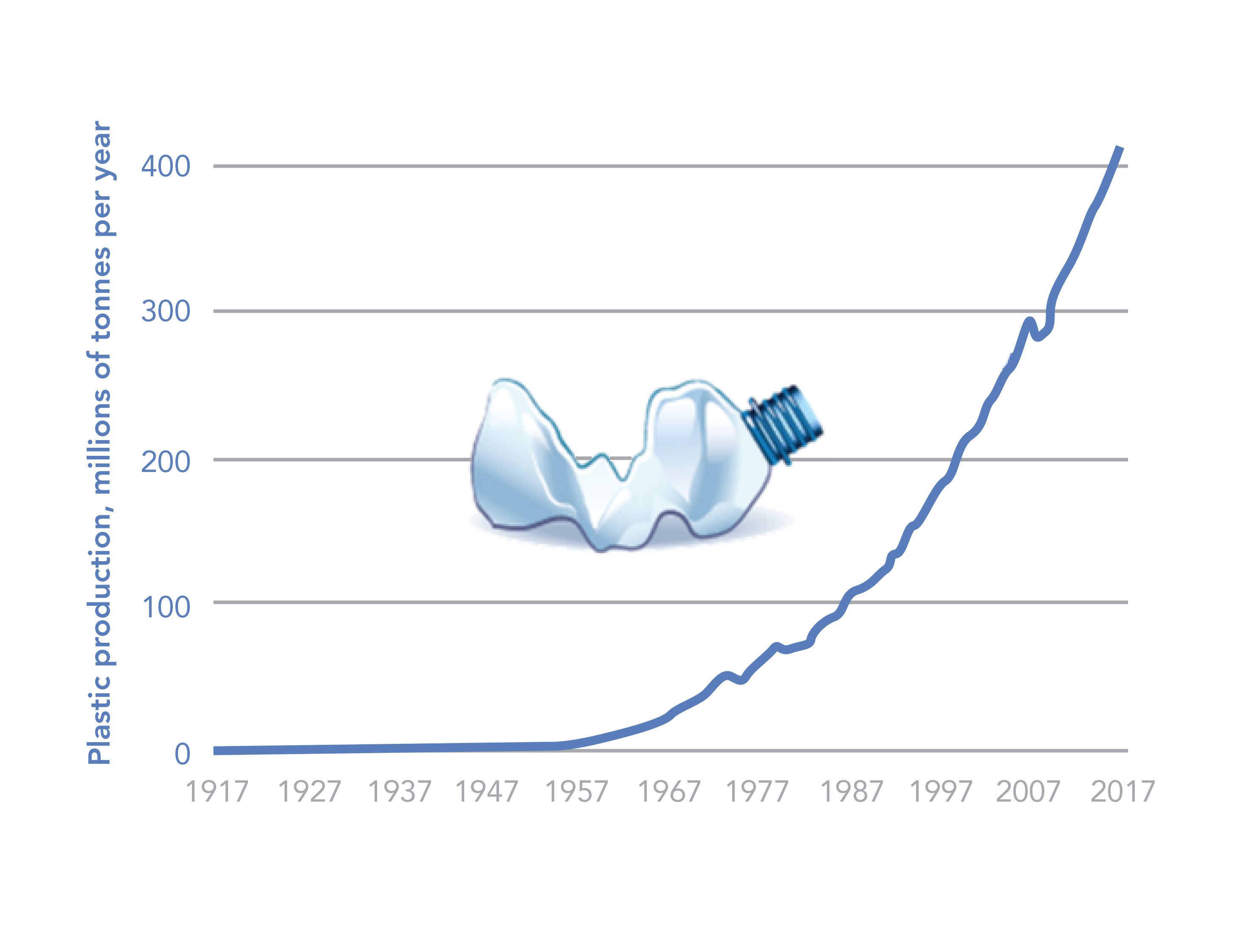
Examination of the sources of these problems can also be misleading. For example, a leading economic model uses surrogate factors for plastic waste mismanagement and depicts non-Western countries as being primarily responsible for the inputs of plastic pollution into the environment (4). These models miss the point that countries like the United States have high per capita plastic consumption with sporadic and inconsistent waste management infrastructure, often exporting large portions of recovered plastic waste to non-Western countries (5). Final disposition of plastic waste exports from Western countries is now a bigger unknown than it was prior to 2018, with likely more plastic ending up in landfills, burned, or accumulating in outdoor heaps and piles and migrating to watersheds, creeks, streams, rivers, and the ocean during wind and rain events. The problem of plastic pollution does not belong to “other” countries, but is very much one of every nation. As plastic debris enters roadways and watersheds, it threatens our natural environment (Figure 2), pollutes and clogs stormwater conveyances, and can pose significant sanitation and public health issues, such as an increase in standing water and mosquito vector growth. As debris enters streams and rivers, micro- and nanoparticles are generated at rates dependent on the forces acting upon them and their polymer type and plastic form. We anticipate that microplastic monitoring will become more prevalent as a means for measuring plastic pollution in the environment.
FIGURE 2: Plastics on Midway Island and stomach contents of an albatross in the NW Hawaiian Islands.
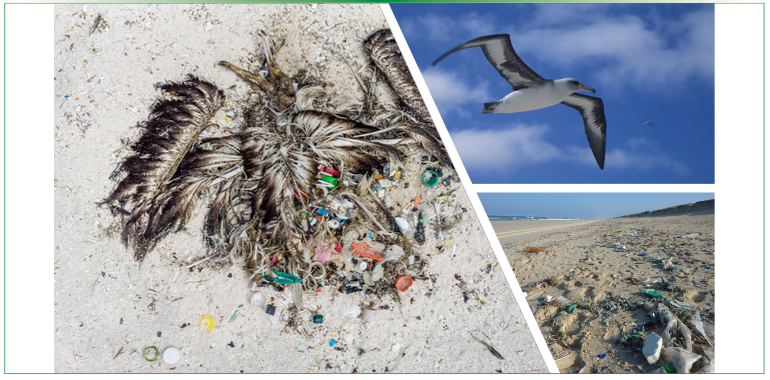
Plastic debris in the environment is not inert. Plastic debris ultimately fragments into smaller particles over time as a result of the effects of weathering, including UV radiation and wind and wave action. As debris breaks down into smaller and smaller particles, polymer surface areas increase relative to their volume, and these surfaces can host pathogens such as bacteria and viruses. These smaller plastic particles, with their relatively higher surface area, have a greater propensity to sorb persistent organic pollutants (POPs) such as polychlorinated biphenyls (PCBs) and pesticides from surrounding air, dust, and water.
Additionally, the manufacturing process of plastic products typically adds chemical constituents, or plasticizers, to augment polymer characteristics and performance, and some of these additives are toxins or carcinogens. It is currently unknown to what extent plasticizers from within microplastics and any sorbed contaminants on the surface of particles are able to desorb, and, upon ingestion by an organism, be taken up by the organism’s tissue and organs (Figure 3). These contaminated microplastics form dust pools both indoors and outdoors. Plastic particles have been documented in every environmental media, and reports in 2019 and 2020 present evidence that plastic is even raining down on us. This pervasiveness and persistence of microplastics and nanoplastics cause some to speculate that scientists of the future will use these plastics as a tool for dating abandoned habitations and geologic strata.
FIGURE 3: Plastic (PE) extracted from a 9 cm lanternfish (myctophid) in the Northern Pacific Ocean.
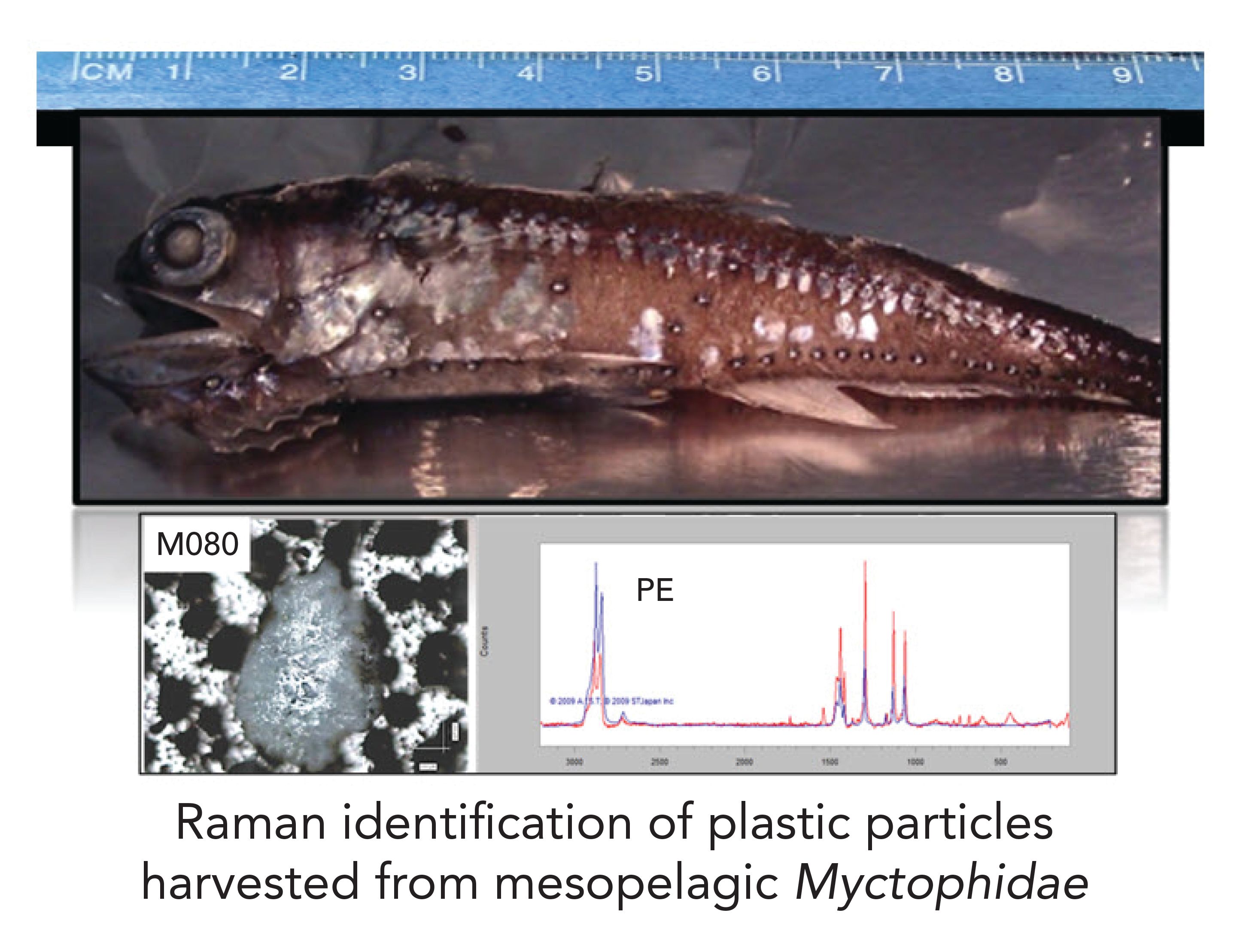
The behavior of microplastics in environmental media is expected to be somewhat more predictive than that of larger debris, which is subject to chaotic ebbs and flows of wind and water. Although plastic fragments may initially float on the water’s surface, they soon become suspended in the water column as they become covered in biological growth; biofouling increases the specific gravity, which decreases buoyancy. It has been assumed that, ultimately, most waterborne microplastics are destined for the floor of an ocean, lake, or river, perhaps being ingested along the way or resuspended through various mechanisms on their way to, and once on, the bottom. However, colloidal suspension and electrostatic interaction between the smallest of these plastic particles and the resulting effect on transport and occurrence in the environment is an area of study that has yet to be explored.
Until recently, calculations of density and distribution of plastic in the environment focused almost exclusively on the visible size range above 300 μm, and employed visual techniques as a means of identification. In addition, these samples were collected on the ocean surface. The majority of microplastics in the environment, both water and air, are now believed to be smaller than 300 μm.
You Can’t Manage What You Can’t Measure
Rigorous and reproducible identification of plastic particles is critical to pollution monitoring. Considering the mantra “you can’t manage what you can’t measure,” effective upstream policy, including corporate and government action to reduce the occurrence of plastic particles, must rely on robust monitoring regimens. Efficacy of mitigation actions will not be measurable without such monitoring, and measurement standards therefore must be agreed on and widely adopted.
The risk of microplastics to our natural environment, and to public health, can be described as the likelihood of harm based on both toxicity and exposure, yet this understanding of risk has been stymied by the lack of rigor, standardization, and reproducibility of measurement practices and methods. While spectroscopy techniques measure plastic particle count, the properties of smaller plastic particles create a sort of fingerprint more easily traced with mass-based concentrations. Mass-based concentrations are much more conducive to benchmark comparisons such as ambient conditions or regulatory thresholds. Measuring concentrations of these tiny plastic particles and their effects on humans and animals necessitates the global standardization of collection, preparation, and identification procedures and methods.
Standardized methodologies for non-destructive collection, handling, separation, sample preparation, and positive identification of microplastics are in the early stages of development. ASTM International is leading the way with recently published standards for collection (D8332) and preparation (D8333) of microplastic particles. Some of the leading technologies currently available that yield scientifically defensible and reproducible results for positive microplastic identification include focal plane array detection, thermo-gravimetric analysis-pyrolysis-gas chromatography-mass spectrometry (Py–GC–MS), and infrared (IR) and Raman spectroscopy.
Presently, most researchers attempting to positively identify polymers are employing IR or Raman spectroscopy for analysis of particle type and count. Information on particle polymer type, count (per unit volume) and size are germane to specific research contexts, and some advanced spectroscopy technologies have reduced operational procedures from upwards of a week to only hours; in most instances, spectroscopy remains time consuming and costly, and requires highly trained and skilled technicians with sophisticated laboratory equipment. Although a high degree of skill is also needed for Py–GC–MS, this technique offers a solution to speed up sample preparation and analysis time, while yielding perhaps more practical information on polymer types and mass per volume.
For water quality monitoring activities such as discharge management, plastic particle identification by mass per unit volume may be more useful for both point source and non-point source measurement. We believe that the use of Py–GC–MS for polymer identification has broader applicability than IR or Raman spectroscopy, because it is less constrained by particle size (large or small), requires less preparation, has fewer interferences, has less potential for analytical error, enables straightforward calibration, provides consistent and highly reproducible results, much lower equipment entry costs, and readily available polymer identification libraries. It is also conducive to varied matrices such as water, soil, and biota, enabling more easily accomplished comparisons.
Here, we outline the development of the Py–GC–MS method, and explain its practical application to understanding the occurrence and prevalence of microplastics, and potentially even nanoplastics, in the environment.
The Role of Py–GC–MS
Recent studies have discovered the unique capability of the microfurnace pyrolysis–GC–MS technique in the identification of polymer types and quantities in microplastic particles. This article describes the study of microplastics in water samples with high and low suspended solids using a microfurnace pyrolyzer directly interfaced with a benchtop gas chromatography–mass spectrometry (GC–MS) instrument.
The samples were collected from drinking water, wastewater influent and effluent, surface water, and marine water. The developed method using the microfurnace Py–GC–MS confirms that the analysis of microplastics in such water samples is independent of polymer type, and not limited to any particular water matrices.
The method proves higher analytical sensitivity for both qualitative and quantitative analyses, including better detection limits. The inorganic contaminants in the sample matrices do not impede the identification and specification of the polymers and associated additives. Detailed information about the chemical nature of the polymer and contained organic additives are also obtained simultaneously.
Most of the initial research on analyzing microplastics was developed using spectroscopy techniques such as Fourier transform infrared (FT-IR) and Raman spectroscopy. These traditional techniques are nondestructive, and commonly used in analytical laboratories. They provide information for functional group identification and library comparison. Detailed information about the contained organic additives is usually not obtained because contaminants (organic or inorganic) and additives can overlap polymer bands. In other words, FT-IR can suffer from peak masking if two or more compounds in a mixture with the same dipole moments absorb IR rays at the same or nearby wavelength. In this case, identifying the overlaid peaks will be extremely difficult. With Raman spectroscopy, measurement of samples that contain fluorescent dyes is very challenging.
The need for sample preparation, such as matrix isolation, solvent extraction, or pre- treatment, is another challenge with these traditional techniques. Typically, it could take several hours to perform the analysis, and quantitation is challenging. The limit on sample particle size with these techniques also must be considered. Micro-Raman spectroscopy and an optical microscope are used for particle size analysis that is larger than 1 μm, whereas FT-IR can be used for particle size larger than 10 μm.
In contrast, microfurnace Py–GC–MS can be used for both qualitative and quantitative analysis of low microplastics concentrations, because of its high sensitivity capability. Although there is no practical lower limit in particle size, total polymer mass in a sample constrains the lower limit of the measurement (see Figure 4). In addition to microplastics, GC–MS adds the benefit of detecting and quantifying both additives and contaminants in the sample using interpretation libraries. Sample preparation is easy and straightforward; micrograms of a sample (including solids taken “as is”) are placed into an inert pyrolysis cup, and the analysis can be performed. The recent developments in F-Search software for microplastics data processing, which is an automated analysis (quantitative and qualitative), has also significantly shortened the time needed for the analysis.
FIGURE 4: Calibration curve for polystyrene.
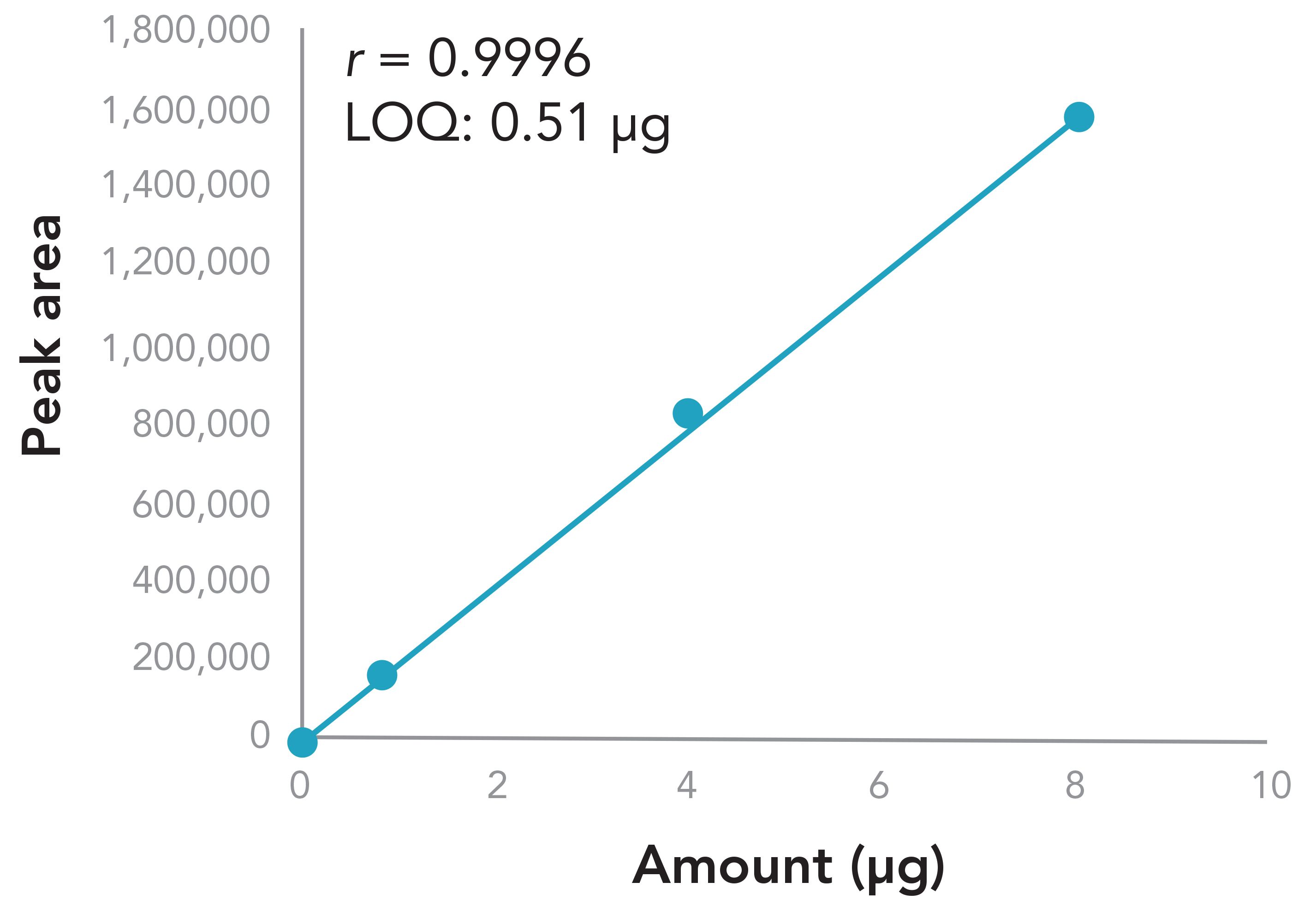
The microfurnace utilizes a low thermal mass ceramic heater to quickly heat and cool with thermal uniformity. This technology can be used for multiple analytical techniques in addition to flash pyrolysis, such as evolved gas analysis (EGA), thermal desorption (TD), double-shot (TD followed by flash pyrolysis), and heart-cutting. All the surfaces are quartz or temperature stable deactivated, and there is no cross-contamination.
The microfurnace performs continuous pyrolysis in a single step by directly depositing all the pyrolyzates on column as they are generated. The direct connection of the microfurnace to the GC injection port allows this single-step pyrolysis where reproducibility and temperature accuracy are obtained. The sample is held near ambient temperature and in an inert atmosphere prior to pyrolysis.
Therefore, there is no chance for evaporation or degradation of the sample before the analysis, maintaining sample integrity, and contributing to accuracy, precision, and reproducibility of the data set. The microfurnace is preheated to the desired temperature, and precisely measured with a thermal couple sensor. The sample cup then freefalls into the quartz pyrolysis tube, where the sample is rapidly and reproducibly pyrolyzed. The pyrolyzates are directly swept onto the GC column for separation and detection by MS. A critical factor with the microfurnace is its ability to control the actual sample temperature to within ±0.1 °C set point of the pyrolysis temperature. This feature guarantees reproducibility and precision, as well as true flash pyrolysis, where the set temperature in the furnace by the analyst reflects the pyrolysis temperature on the sample.
There are other pyrolysis technologies: filament, which uses platinum coil wire, and Curie-point, which utilizes a ferromagnetic foil. These technologies can suffer from poor temperature accuracy and poor reproducibility because of non-uniform heating. In both systems, to avoid condensation of the pyrolyzates, the sample must be inserted into a heated manifold before pyrolysis. This preheating step can cause degradation or thermosetting of the samples prior to analysis. With filament pyrolyzers, sample placement and heat-transfer variations also affect the temperature of the sample, depending on where the sample sits in relation to platinum wire coils and on sample contact. The filament temperature is estimated from the electrical properties of the wire, but the temperature of the sample is not actually measured as it changes over time. In other words, the platinum wire can only control the temperature of its heating element, not the actual sample pyrolysis temperature, requiring the user to program the system at a much higher temperature than the desired true pyrolysis temperature on the sample.
In a study of microplastics in surface water using a filament pyrolyzer, the pyrolysis temperature was set at 750 °C, with the sample placed in a narrow quartz tube inside the platinum wire (6). Based on actual bond energy strengths, polymers and other organic material will typically pyrolyze prior to a temperature of approximately 700 °C.
Therefore, the only reason to set an initial pyrolysis temperature in excess of 700 °C is that the actual sample temperature in the pyrolyzer is not accurate. Literature indicating pyrolysis at 1200 or 1300 °C is either unnecessary, over pyrolysis, or shows poor actual sample temperature control in the particular pyrolysis device.
It is critical to note that some filament pyrolyzers perform 2-step pyrolysis. First, some of the pyrolyzates are collected on a trap, and then a switching valve sends the pyrolyzates from the trap through a long transfer line into the GC column. In this configuration, the pyrolyzates are indirectly placed on column. During this two-step process, polar and heavy compounds may cause cross-contamination, or become irreversibly stuck in the trap or the long transfer line, and are not transferred for analysis because of the potential of cold spots in the system.
Materials and Methods
Figure 5 shows the system configuration of the microfurnace pyrolysis-GC–MS used for microplastic analysis in the water samples. Experiments are performed with a microfurnace pyrolyzer (EGA/PY-3030D, Frontier Laboratories Ltd.) with Auto-Shot Sampler (AS-1020E, Frontier Laboratories Ltd.) coupled to a GC–MS system (5977B MDS, Agilent Technologies, or GCMS QP-2020NX, Shimadzu Corporation). Chromatographic separation is achieved using a metal capillary column (UA-5, 0.5 μm film of 5% diphenyl-95% dimethylpolysiloxane, 30 m x 0.25 mm, Frontier Laboratories Ltd.) with helium (He) as the carrier gas (1 mL/min). Reduced analysis time can be obtained by utilizing a backflush system, especially when dealing with high- boiling point matrix interference or high molecular weight pyrolysis products. This system consists of a precolumn (UA-50, 1 μm film 50% diphenyl 50% dimethylpolysiloxane, 2 m x 0.25 mm, Frontier Laboratories, Ltd.) connecting the injector and the separation column with a three-way split (7).
FIGURE 5: Pyrolysis-GC–MS system configuration using a microfurnace pyrolyzer.
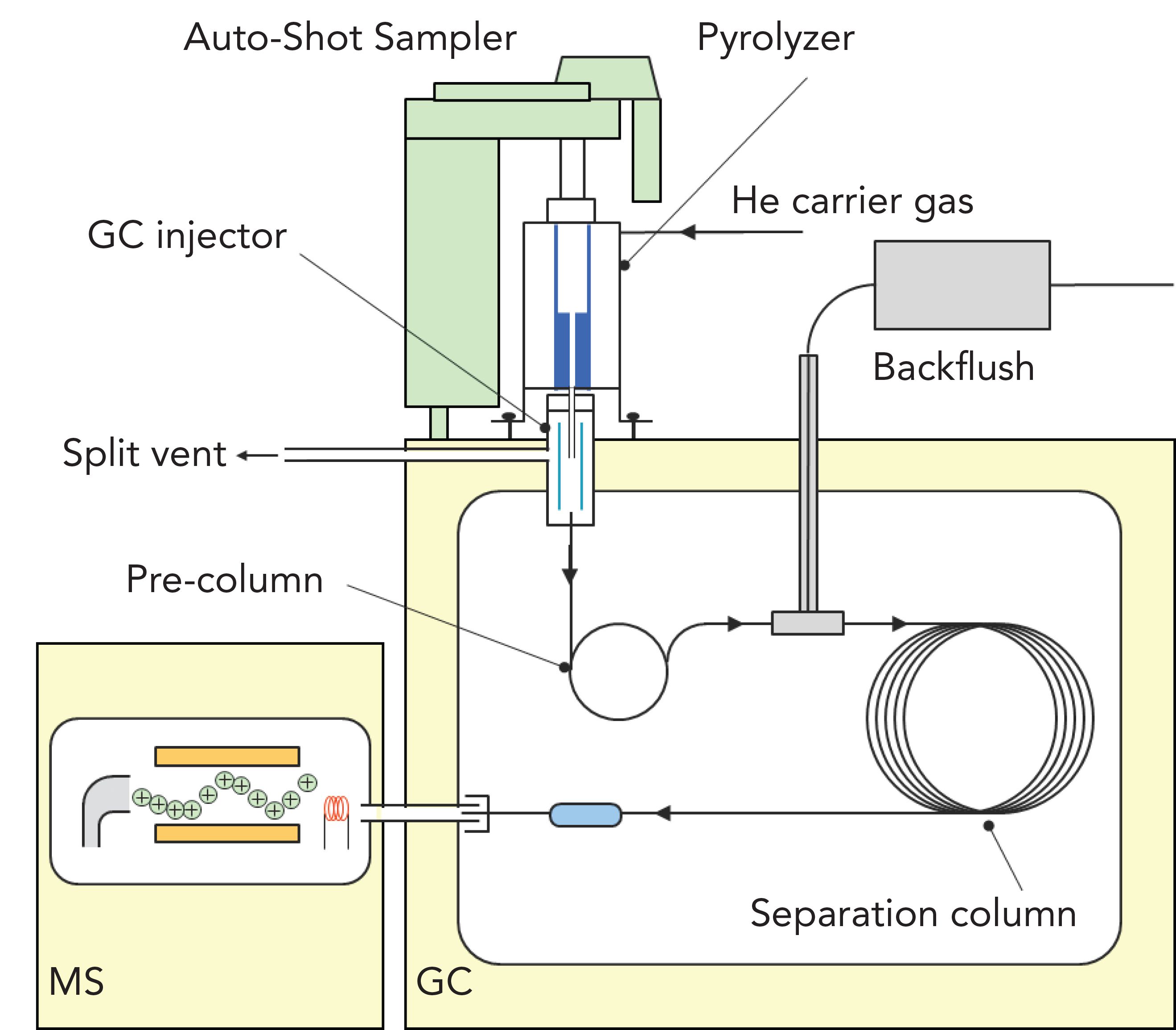
Using the flash pyrolysis mode of operation (the single-shot mode) of the microfurnace, the chemical composition analysis is performed on microplastic samples. The microfurnace is programmed at 600 °C to break down the organic bonds of the samples into smaller and more stable molecules, referred to as pyrolyzates. The pyrolyzates are directly swept from the pyrolysis tube into a GC column, via a needle fixed in a split injection port. The column is interfaced directly to an MS instrument. The chemical species are ionized and sorted, based on their mass-to-charge ratio. Compounds eluted from the GC column are identified by comparing the mass spectra at a predetermined retention time to reference spectra and retention index (RI) to those contained in a database.
Results
Table I shows some of the polymers that can be identified using microfurnace Py–GC–MS. The validation is performed using a pyrolyzate primary quantitative ion and identification ion(s) representative of a specific polymer. It is important to note that the developed method is not limited to the polymers listed in the table below.
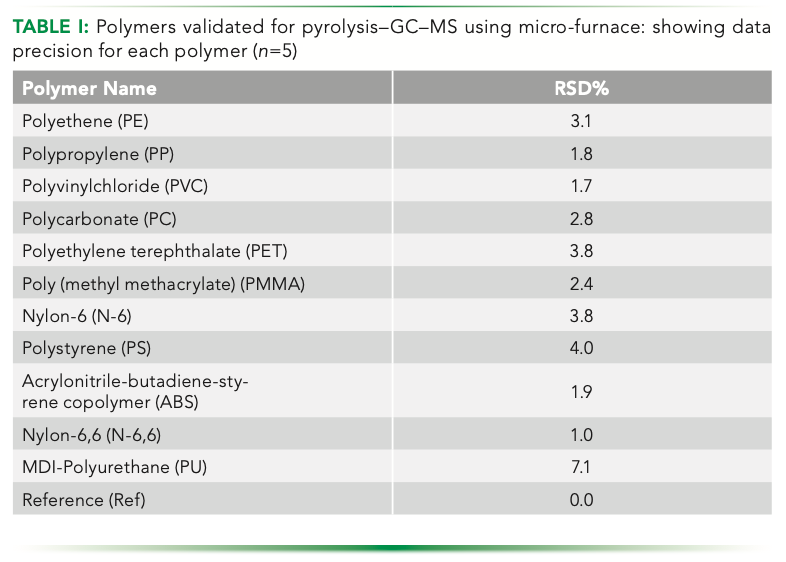
Figure 6 demonstrates a typical pyrogram of the 11 target pyrolyzates and their associated polymer (in parenthesis), using the developed method described above.
FIGURE 6: Typical pyrogram of 11 target polymers using microfurnace technique.
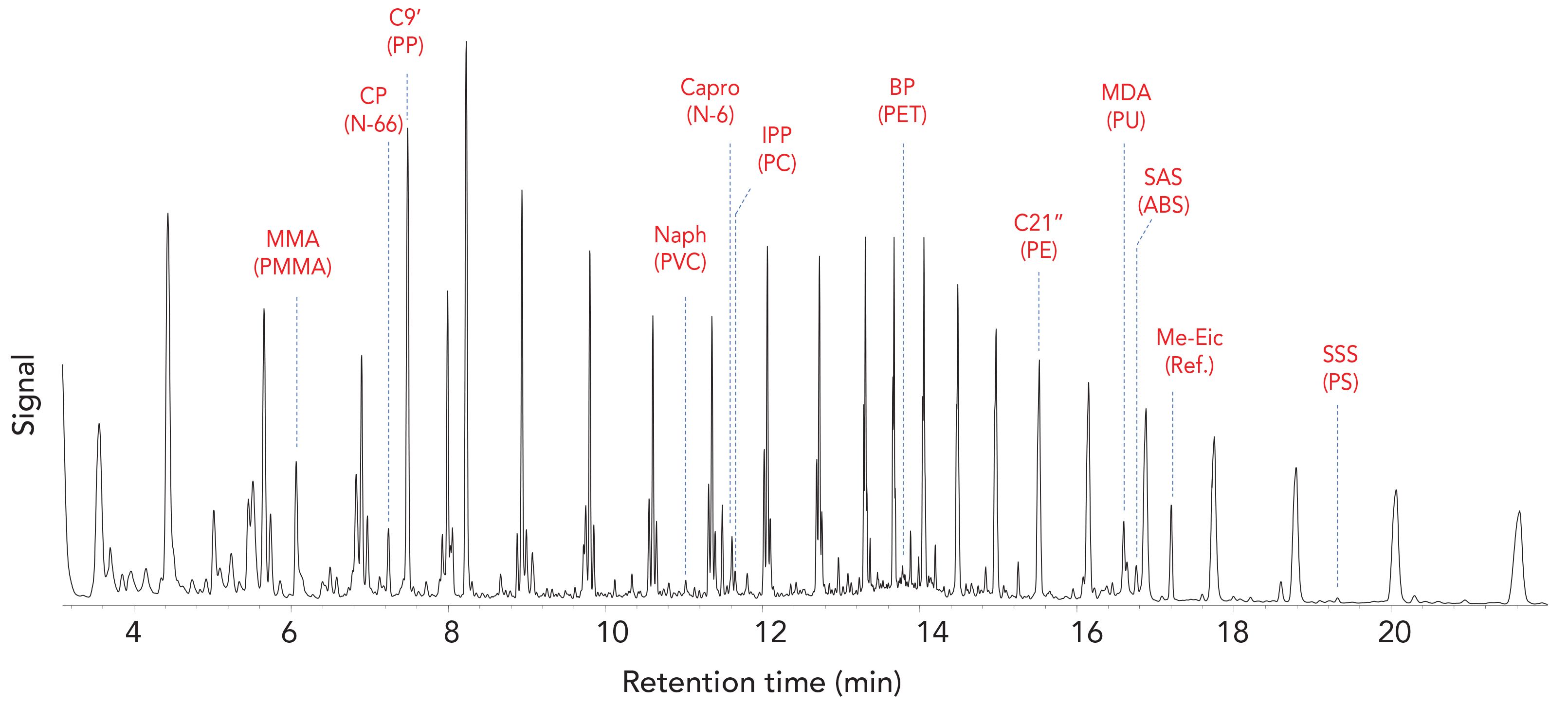
The concentration of each identified polymer is determined using either internal or external standard calibration. Using a multi-component standard (8), the calibration curves can be obtained. Table I lists the data precision of each polymer for n = 5.
Data Processing Using F-Search
As mentioned earlier, F-Search, an automated search program, has been augmented for the fast identification and quantitation (in the range of seconds) of microplastics. The search algorithm is based on the identification of the selected number of characteristic pyrolyzates of each polymer in the sample. Each selected pyrolyzate is only obtained from the pyrolysis of a polymer, and not from the pyrolysis of all other investigated polymers. For each characteristic pyrolyzate, a set of specific m/z signal intensities is also selected. A normalized summated mass spectra (SMS) is obtained from the selected m/z signal intensities so that the mass spectra are cleared from any interfering signals due to co-eluted species. The similarity of the obtained SMS with the one in the library is calculated and expressed as a percentage. A signal-to-noise ratio (S/N) is calculated for each polymer by extracting a characteristic m/z signal chosen from one of the main pyrolyzates. If the S/N is lower than a set threshold, the presence of the corresponding polymer is excluded, regardless of the similarity index obtained by the algorithm.
Figure 7 demonstrates an example of the identification process of polypropylene (PP) in the reference mixture using the automated F-Search program. The ions at m/z 41, 43, 55, and 70 were selected as the representative four pyrolyzates of PP. The peaks of each characteristic pyrolyzate identified in the extracted ion chromatograms (EICs) are marked with dots. The SMS of these peaks was then compared with that obtained for reference PP. Because a similarity of 98.4% was obtained, the presence of PP in the reference mixture was confirmed. The results obtained with the algorithm for the two samples are summarized in Table II (5), along with the calculated S/N values and the limit of detection of the algorithm. Both a high match and S/N greater than the set threshold were obtained for all polymers in the reference mixture.
FIGURE 7: Identification process for PP in reference mixture using F-Search automated algorithm.

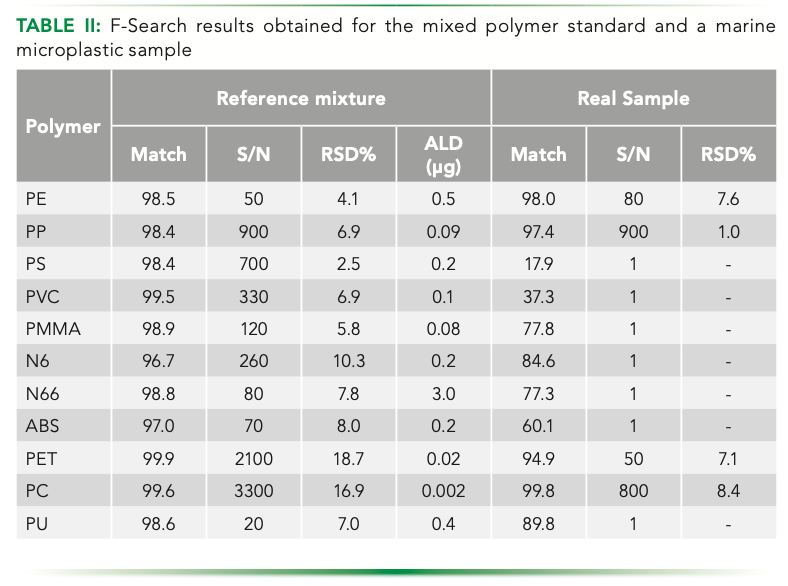
Summary
The microfurnace Py–GC–MS technique provides detailed information about polymers, additives, and even contaminants. The identification of polymers is rapid and automated, easy to use in different laboratory setups, and less costly compared to traditional spectroscopy techniques. Neither the presence of biofouling nor that of contaminants or additives impedes the identification and quantitation of polymer types.
The sample preparation is easy and straightforward; the sample is placed into an inert sample cup, and held in the ambient atmosphere before the analysis starts. Once the furnace achieves the desired temperature as programmed by the user, the sample cup freefalls into the microfurnace, where rapid and reproducible pyrolysis happens. All the generated pyrolyzates are directly placed on column in a single step, foregoing the need for a transfer line or chemical trap.
The F-Search automated program significantly increases analytical efficiency by providing polymer identification in a matter of seconds. Microplastics are often a mixture of polymers and additives, and in most cases, they are co-eluted, so identification using spectroscopy techniques is challenging. However, the co-elution of compounds and contamination in the microplastic mixture samples does not affect the ability of microfurnace Py–GC–MS to provide simultaneous identification and specification of polymers and additives.
Another advantage of this technique is the elimination of solvent extraction or sample pretreatment before analysis. The microfurnace can be used for thermal desorption analysis where the additives and light compounds are thermally extracted from a mixture. Laboratories save money over time by using fewer solvents, while also protecting analysts and the environment from solvent exposure and hazards.
The microfurnace produces reproducible data, and controls the actual sample temperature to within ±0.1 °C of the pyrolysis temperature. Other types of pyrolyzer devices can only control the temperature of the heating element, and not the actual sample temperature. Also, the ability of the microfurnace to protect the sample from any heat prior to the analysis and the absence of the transfer line makes it possible to analyze a wide range of compounds, including additives, volatiles, light, heavy, polymeric, and polar compounds.
The collection approach and sample number must always be considered in the analysis of microplastics. Often, water samples are filtered to collect the microplastic mixture. With Py–GC–MS, only a small amount of sample (microgram quantities) is needed, and multiple analyses can be performed with one-time sampling. This new Py–GC–MS method is currently under development as an official ASTM method by an ASTM International workgroup.
A concerted effort must be made to standardize and make widely available these types of sampling and analytical methodologies, as well as streamline methodologies and reduce their costs. As the demand for microplastics measurement and monitoring increases, practitioners must have access to reliable and repeatable methods. Ideally, these methods would provide both qualitative and quantitative information, and be comparable to other standardized and commonly used environmental measurement techniques.
The ability to adapt these technologies for field deployment is essential to gain a better understanding of the quantity, distribution, and behavior of plastic particles in all environmental matrices. Common reporting of microplastic concentration data will support both government and industry responses to the growing crisis of plastic pollution. As described, microplastic measurement provides advantages over traditional debris monitoring. Mass-based analysis is directly comparable to other environmental contaminant analysis methods, and has an advantage over spectroscopy techniques because it avoids complicated preparation and the need to count individual particles after identification.
New frontiers in microplastic measurement and monitoring require robust and repeatable analytical techniques. Analytical information should be the cornerstone of corporate and government pollution mitigation efforts, and Py–GC–MS will be critical in the evaluation of efforts to curb plastic pollution around the world.
Acknowledgments
The authors wish to thank the scientists at Frontier Laboratories whose work made this article possible: T. Ishimura, I. Iwai, M. Matsueda, A. Shiono, K. Matsui, N. Teramane, and C. Watanabe.
Disclaimer
The views expressed in this article are those of the authors and do not necessarily reflect the views or policies of the U.S. Environmental Protection Agency.
References
(1) https://www.darrinqualman.com/global-plastics-production/
(3) https://www.draper.com/sites/default/files/2018-11/EPAMicroplasticsFactSheetOctober2018.pdf
(4) J.R. Jambeck, A. Andrady, R. Geyer, R. Narayan, M. Perryman, T. Siegler, C. Wilcox, and K. Lavender Law, Science 347, p. 768–771 (2015). https://www.iswa.org/fileadmin/user_upload/Calendar_2011_03_AMERICANA/Science-2015-Jambeck-768-71__2_.pdf
(5) https://www.grida.no/resources/13333
(6) B. Ravit, K. Cooper, G. Moreno, B. Buckley, I. Yang, A. Deshpande, S. Meola, D. Jones, and A. Hsieh, AIMS Environmen. Sci. 4(6), 809–826. (2017). https://www.aimspress.com/article/10.3934/environsci.2017.6.809
(7) K. Matsui, T. Ishimura, M. Mattonai, I. Iwai, A. Watanabe, N. Teramae, H. Ohtani, and C. Watanabe, J. Anal. Appl. Pyrolysis 149, 104834 (2020) https://www.sciencedirect.com/science/article/abs/pii/S0165237020300899
(8) M. Matsueda, M. Mattonai, I. Iwai, A. Watanabe, N. Teramae, W. Robberson, H. Ohtani, Y-M. Kim, C. Watanabe, J. Anal. Appl. Pyroly. 154, 104993 (2021) https://www.sciencedirect.com/science/article/abs/pii/S0165237020300899https://committee.iso.org/files/live/sites/tc61/files/The%20Plastic%20Industry%20Berlin%20Aug%202016%20-%20Copy.pdf
ABOUT THE AUTHORS
William Pipkin is the President of ATRq, in Orem, Utah. Rojin Belganeh is the Technical Director of Frontier Americas, in Houston, Texas. William Robberson is the founder and Principal Engineer at Ocean P3 Systems, in San Francisco, California, and a former engineer for the U.S. Environmental Protection Agency (USEPA), Region 9, in San Francisco, California. Harry L. Allen is an environmental scientist with EPA Region 9 Superfund Division and is based in Los Angeles, California. Anna-Marie Cook is Co-founder & CEO of Kamilo, Inc. in Oakland, California, and a former engineer for USEPA Region 9. Atsushi Watanabe is the Vice President and Manager of Global Product Marketing at Frontier Laboratories, in Koriyama, Japan. Direct correspondence to: william.pipkin@gmail.com

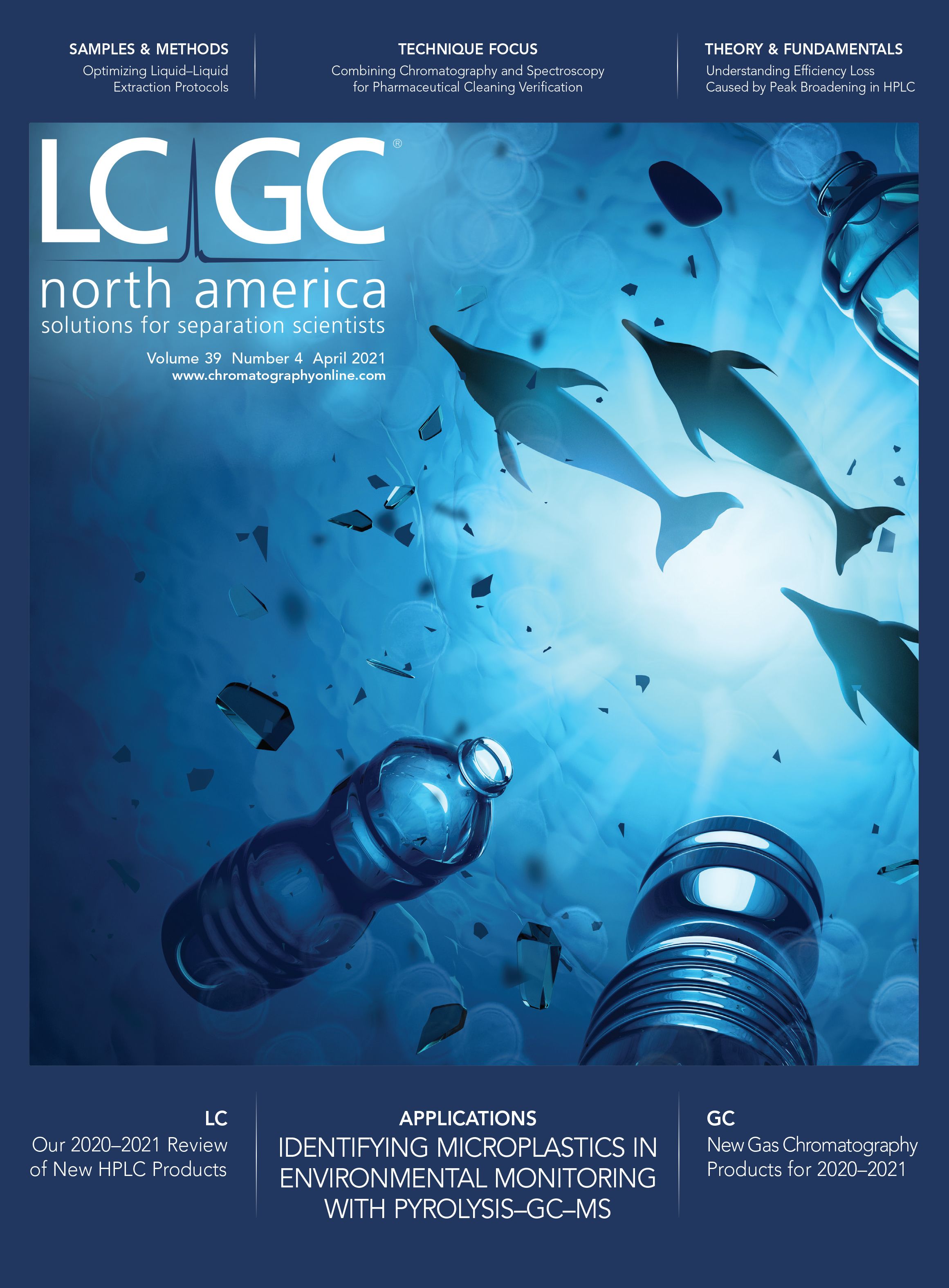
University of Tasmania Researchers Explore Haloacetic Acid Determiniation in Water with capLC–MS
April 29th 2025Haloacetic acid detection has become important when analyzing drinking and swimming pool water. University of Tasmania researchers have begun applying capillary liquid chromatography as a means of detecting these substances.
New Study Reviews Chromatography Methods for Flavonoid Analysis
April 21st 2025Flavonoids are widely used metabolites that carry out various functions in different industries, such as food and cosmetics. Detecting, separating, and quantifying them in fruit species can be a complicated process.

.png&w=3840&q=75)

.png&w=3840&q=75)



.png&w=3840&q=75)



.png&w=3840&q=75)










